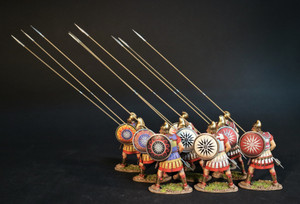
by Murray Dahm (Author), Peter Dennis (Illustrator)
In August 334 BC, Alexander the Great invaded the Persian Empire and systematically set about its conquest. At the core of Alexander's army were 10,000 members of the phalanx, the phalangites. Armed with a long pike and fighting in formations up to 16 ranks deep, these grizzled veterans were the mainstay of the Macedonian army.
Facing them were the myriad armies of the peoples that made up the Persian Empire. At the centre of these forces was the formation known as the Immortals: 10,000 elite infantry, armed with spears and bows.
In this study, a noted authority assesses the origins, combat role and battlefield performance of Alexander's phalangites and their Persian opponents in three key battles of the era – the Granicus River, Issus and Gaugamela – at the dawn of a new way of waging war.





